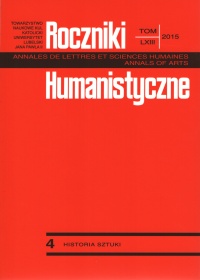Fantasy or a transcendent experience? Study of the painting Ascent into Heaven by Jheronimus Bosch from the Palazzo Ducale in Venice
Abstract
The painting Ascent into Heaven (88.8 x 39.9 cm; dendrological dating: 1482-1490) kept in the Palazzo Ducale in Venice is one of the four eschatological panels (remaining three: Earthly Paradise, Fall of the Damned, Hell) which probably were in the collection of the Venetian Cardinal Domenico Grimani in the 1520s. The panels’ original arrangement and function are unknown. The paintings are not signed and their attribution to Jheronimus Bosch (c. 1450-1516 ) is based largely on the grounds of stylistic criteria. In the study I put Ascent into Heaven into two fundamental contexts for the iconographic analysis of this work: eschatological literature and Netherlandish/ Flemish painting and in the context of near-death experiences (NDE) as well. The answer to the question posed in the title of the study must remain twofold. On the basis of the data gathered in the study the content of the painting can be comprehended by reference to the most frequently quoted sources of inspiration for Bosch: one painting by Dieric Bouts (left wing of the Last Judgement Altarpiece; Lille, Palais des Beaux Arts), two illuminations by Simon Marmion (Le livre des sept Ages du monde; Brussels, Bibliothèque royale de Belgique, Ms. 9047, fols. IV & 12r) and a literary work Dat rike der ghelieven by Jan van Ruusbroec. Its content can be equally understood by reference to the role of the painter’s imagination (categories of inventio and fantasia), using his theological and astronomical knowledge. The above line of interpretation that emphasizes the influence of biblical logosphere, takes into account undeniable religious experience of the painter from ‘s-Hertogenbosch resulting from being a member of the Church. The factor of an epistemological importance which influences the form of the answer to the title question is hypothetical non-verifiable Bosch’s personal transcendental experience, thus it becomes impossible to evaluate the translation of what is spiritual (experience) into visual (image). Due to the elusive, not fully scientific nature of NDE this fenomenon should be excluded from the final conclusion.
References
Baldass von L., Hieronymus Bosch, przekł. b.d., New York 1960 (Wien 1941).
Belting H., Kruse C., Die Erfindung des Gemäldes. Das erste Jahrhundert der niederländischen Malerei, München 1994.
Bokwa I. (red.), Breviarium fidei. Wybór doktrynalnych wypowiedzi Kościoła, wyd. III, Poznań 2007.
Borchert T.-H. (red.), The Age of Van Eyck. The Mediterranean World and Early Netherlandish Painting 1430-1530, przekł. T. Alkins, inni, Ghent-Amsterdam 2002.
Buzzati D., Cinotti M., L’opera completa di Bosch, Milano 1966.
Daniélou J., Aniołowie i ich misja, przekł. K. Kubaszczyk, Warszawa-Ząbki 2006.
Dinzelbacher P., Himmel, Hölle, Heilige. Visionen und Kunst im Mittelalter, Darmstadt 2002.
Dixon L., Hieronymus Bosch, New York 2003 (repr. 2006).
Eliade M., Sacrum a profanum. O istocie sfery religijnej, przekł. B. Baran, Warszawa 2008.
Eliade M., Traktat o historii religii, przekł. J. Wierusz Kowalski, Warszawa 2000.
Elsig F., Jheronimus Bosch. La question de la chronologie, Genève 2004.
Fischer S., Hieronymus Bosch. Malerei als Vision. Lehrbild und Kunstwerk, Köln 2009.
Fischer S., Hieronymus Bosch. The Complete Works, przekł. K. Williams, R.-le-Châteu, Köln 2013.
Gardiner E., Medieval Visions of Heaven and Hell. A Sourcebook, New York 1993.
Gibson W. S., Hieronymus Bosch, London 1973 (repr. 2001).
Grant E., Planets, Stars, and Orbs. The Medieval Cosmos, 1200-1687, New York 1994.
Harris L., The Secret Heresy of Hieronymus Bosch, wyd. II, Edinburgh 2002.
Keck D., Angels and Angelology in the Middle Ages, New York 1998.
Koldeweij J., Vandenbroeck P., Vermet B., Hieronymus Bosch. The Complete Paintings and Drawings, przekł. T. Alkins, Rotterdam 2001.
Koldeweij J., Vermet B., van Kooij B. (red.), Hieronymus Bosch. New Insights Into His Life and Work, przekł. B. O‘Brien, R. Koenig, inni, Rotterdam 2001.
Larsen E., Hieronymus Bosch, New York 1998.
Le Goff J., Narodziny czyśćca, przekł. K. Kocjan, Warszawa 1997.
Levy B.S. (red.), The Bible in the Middle Ages. Its Influence on Literature and Art, Binghamton 1992.
Limentani Virdis C. (red.), Le Delizie dell’inferno. Dipinti di Jheronimus Bosch e altri fiamminghi restaurati, Venezia 1992.
Łukaszuk T.D., Ostateczny los człowieka i świata w świetle wiary katolickiej. Zarys eschatologii katolickiej, Kraków 2006.
Marijnissen R.H., Ruyffelaere P., Hieronymus Bosch. Das vollständige Werk, przekł. H. Beyer, Antwerpen 1999.
McKendrick S., Flemish Illuminated Manuscripts 1400-1550, London 2003.
Oleschko H. (red.), Księga o aniołach, Kraków 2002.
Reuterswärd P., Hieronymus Bosch’s Four ‘Afterlife’ Panels in Venice, „Artibus et Historiae”, 24 (1991), s. 29-35.
Ruysbroeck van J., Królestwo miłujących, [w:] Bł. Jan van Ruusbroec. Dzieła, przekł. M. Lew-Dylewski, t. I, Kraków 2000.
Silver L., Hieronymus Bosch, New York 2006.
Simek R., Erde und Kosmos im Mittelalter. Das Weltbild vor Kolumbus, München 1992.
Tolnay de C., Hieronymus Bosch, przekł. b.d., New York 1966 (Basel 1937).
Vandenbroeck P., Jheronimus Bosch. De verlossing van de wereld, Ghent-Amsterdam 2002.
Waadenoijen van J., De ‘geheimtaal’ van Jheronimus Bosch. Een interpretatie van zijn werk, Hilversum 2007.
Copyright (c) 2015 Roczniki Humanistyczne

This work is licensed under a Creative Commons Attribution-NonCommercial-NoDerivatives 4.0 International License.





